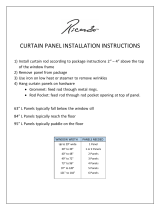Page is loading ...

16-3690 (09/16)
Rod Face Width
Measuring Guide
for Drapery
Determining the Width of the Area to be Covered
Minimum Rod Placement
Face Width = glass width + 8" (4" per side)
Stack Back Consideration
Additional wall coverage may be needed in
order for the drapery to stack back off the
glass when opened.
The general rule is that the total stack back
needed is approximately
1
⁄3 the width of the
window. Additional width may be needed for
heavy or bulky fabrics.
Face Width = glass width + total stack back
Bracket to Bracket Face Width
Inside Finial to Inside Finial Face Width
End to End Face Width
Return Projection
Measure from the wall to the face of the rod.
Consider the look you want to create when determining the type of drapery hardware and its placement. Rod type and placement
determine the width and length of the draperies needed. General guidelines follow.
Width
There are only two measurements you need to determine the width of the drapery: the face width to be covered and the
projection of the rod.
Two-Way Draw
Face Width
Glass Width
1
⁄2 of
Stack
Back
1
⁄2 of
Stack
Back
Rod Face Width
Face Width
Glass Width
+4 +4
Drapery Width
One-Way Draw
Face Width
Glass Width
Total Stack Back
+4
Rod Face Width
Return
Projection
Double-
check your
work—always
measure twice
to ensure
accuracy.
Tools and Tips
• Steel tape measure —
do not use cloth tape
• Pencil
• Round measurements
to the nearest
1
⁄8"
1/8"
1/4"
3/8"
1/2"
5/8"
3/4"
7/8"

16-3690 (09/16)
Determine Your Starting Point (based on the type of rod and style of drapery you have chosen)
Type of Drapery Starting Point Type of Drapery Starting Point
Pleated
Rod Pocket Top
and Bottom
Grommet Top
Roll Pleat
TabPlain Top
Rod Pocket
Determine the Length to be Covered: the bottom stopping point of your drapery. The five most popular styles are below.
Determine your drapery style and the type of drapery hardware you will use (see drapery styles and hardware summary chart for
pairing options).
Length
There are only two measurements you need to determine the length of the drapery: the length you want to be covered and the
starting point of the drapery.
Drapery Length
Sill
Top of sill less
1
⁄2"
Apron
Bottom of apron plus 1"
Floor
(1)
Top of floor less
1
⁄2"
Trouser
Top of floor plus 2"
Puddle
Top of floor plus 6"-10"
(1) When using a drapery under another drapery, 1" above floor is recommended.
Measure from above starting point.
• Roll pleat rod
Bottom of rod
• Decorative
traverse rod
with rings
• Decorative pole
with rings
Bottom of ring
• Decorative
traverse rod
with glides
Bottom of rod
• Traverse rod
• Curtain rod
Top of rod
• Decorative pole
(length does not
include heading)
Top of pole
• Decorative pole
• Length includes tabs
Top of pole
• Decorative pole
• Length includes tabs
Top of pole
• Decorative pole
Top of pole
• Decorative pole
(length does not
include fabric
above the rod)
Top of pole
• Sash rods
• Tension rods
• Length does not
include headers
Top of top rod
• Decorative pole
with clip rings
Top of clip hinge
Bottom of bottom rod

16-3690 (09/16)
Type of Rod Drapery Style Face Width Length
Return
Projection
Minimum
Recommended
Rod Placement
Other
Considerations
Curtain Rod
Pleated or decorative
panels with valance
over them
Rod pocket
Bracket to bracket
Top of rod to
desired length
Wall to front of rod
4" to 5"
above the glass
When ordering a
rod pocket drapery,
the heading is NOT
included in the
finished length
Decorative Pole
Grommet top
Rod pocket
Tab styles
Inside finial to
inside finial
Top of pole to
desired length
6
1
⁄2" to 7"
above the glass
When ordering a
rod pocket drapery,
the heading is NOT
included in the
finished length
Decorative Traverse
Pleated
Inside finial to
inside finial
With slides:
bottom of rod to
desired length
With rings:
bottom of ring to
desired length
Wall to front of rod
6
1
⁄2" to 7"
above the glass
Returns are strongly
recommended to
prevent light seepage
Traverse Rod
Pleated Bracket to bracket
Top of rod to
desired length
Wall to front of rod
4" to 5"
above the glass
Typical projections—
single traverse rod:
3
1
⁄2"
double traverse rod:
5
1
⁄2"
Returns offered:
2
"
,
4", 6"
Decorative Pole
with Rings
Pleated
Plain top
Rod pocket
Inside finial to
inside finial
Using eyelet:
bottom of ring to
desired length
Using clip:
hinge of clip to
desired length
Wall to front of rod
6
1
⁄2" to 7"
above the glass
Sash or Tension
Top and bottom rod Bracket to bracket
Top of top sash rod
to bottom of bottom
sash rod
Sash rod:
1" to 2" above
and below the glass
Tension rod:
desired length
When ordering a
rod pocket drapery,
the heading is NOT
included in the
finished length
Roll Pleat Style Rod
Roll pleat
(100 or 120 fullness)
End to end Bottom of rod
Approximately
3
1
⁄2"
5" to 6"
above the glass
Specify butt or
overlap master glides
when ordering
Drapery Styles and Hardware Summary
/



